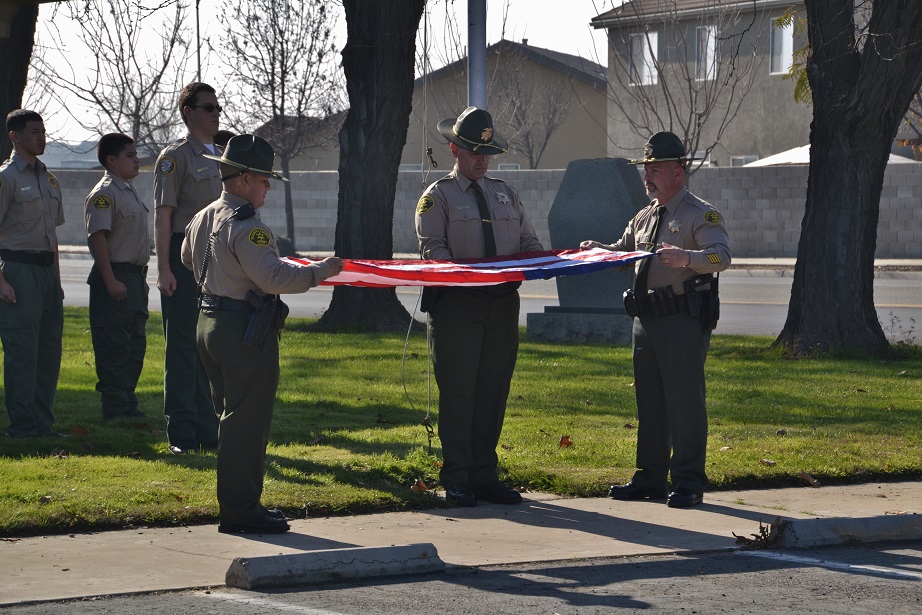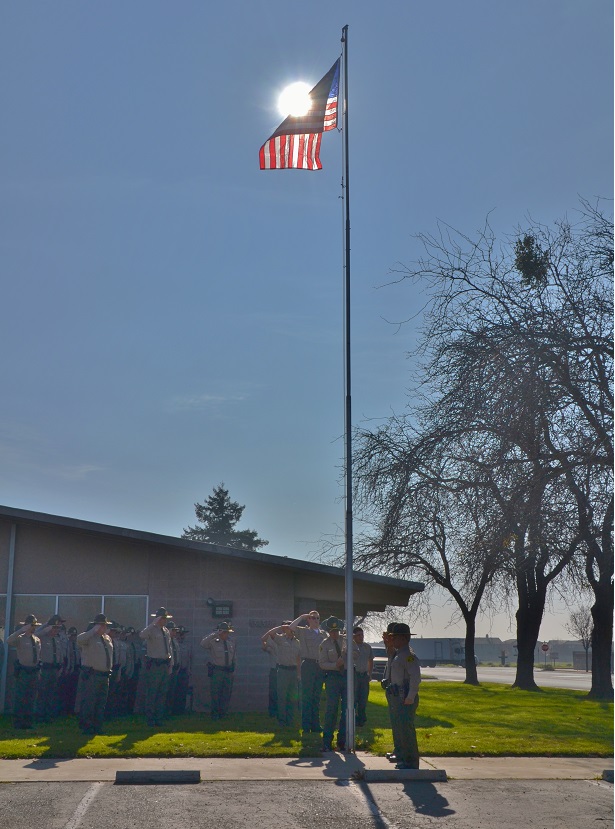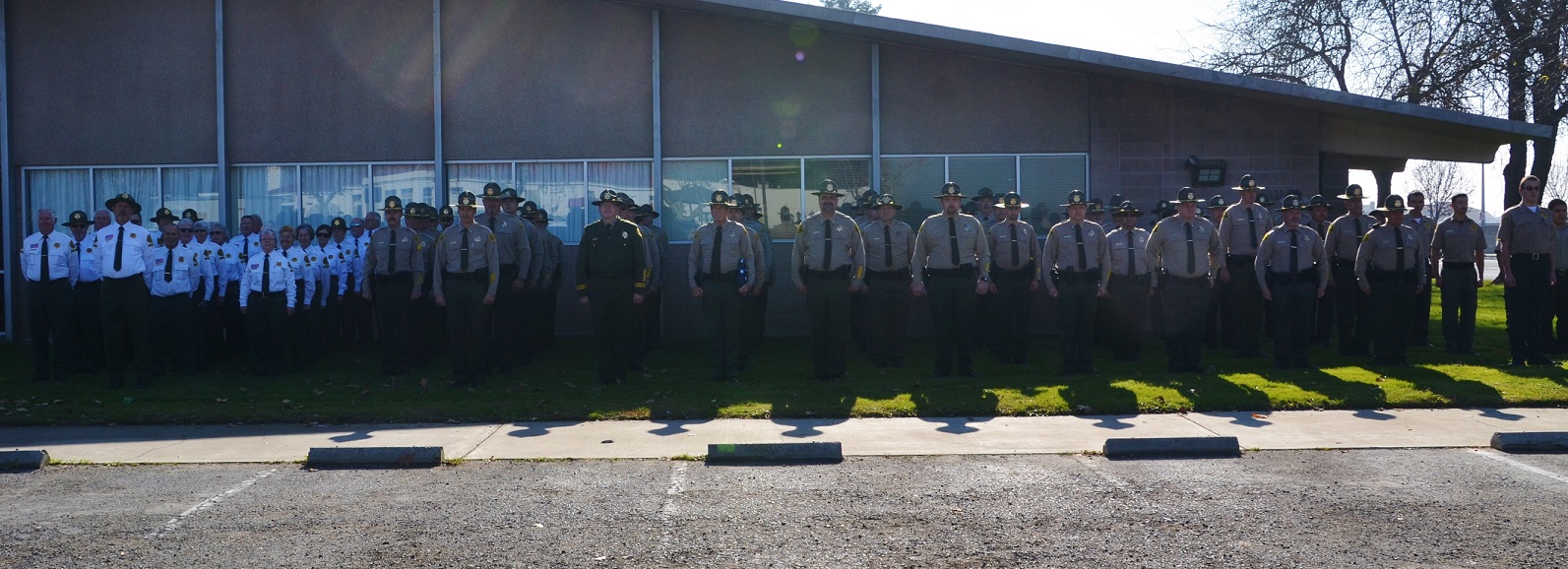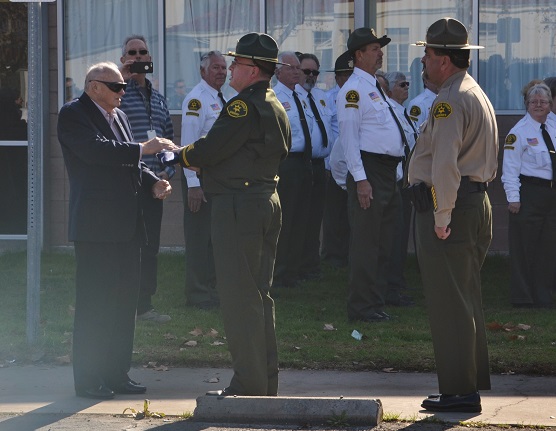MADERA COUNTY – In what is called “the Passing of Colors,” newly elected Sheriff Jay Varney and outgoing Sheriff John Anderson together gave a command performance outside the Madera County Sheriff’s Office yesterday.
This long-standing military tradition was shared with hundreds of citizens looking on, and was bittersweet for the team of sworn personnel at the Sheriff’s Office, who are bidding farewell to their leader of 16 years.
Sheriff Jay Varney and retired Sheriff John Anderson spent a decade working together, and have always considered each other both a friend and an ally. They have worked together on a number of county projects, including the Peace Officers Monument that now stands in Courthouse Park. Sheriff Varney says it was an honor to share this most auspicious day with John Anderson.
 During yesterday’s ceremony, Madera County Sheriff’s Deputies lowered the American flag, which was presented to Sheriff Anderson. World War II Marine Corps veteran Harrison Desmond presented Sheriff Jay Varney with a flag that was then raised during the ceremony, to mark the official transfer of leadership or “Change of Command.”
During yesterday’s ceremony, Madera County Sheriff’s Deputies lowered the American flag, which was presented to Sheriff Anderson. World War II Marine Corps veteran Harrison Desmond presented Sheriff Jay Varney with a flag that was then raised during the ceremony, to mark the official transfer of leadership or “Change of Command.”
After more than three decades with the California Highway Patrol, and serving Madera County for four terms in office, Sheriff John Anderson has now officially retired the uniform, but leaves in place a long list of innovations at the department.
Anderson has often said, “Madera County doesn’t have a crime problem. Madera County has a drug problem,” and in 1999, he successfully launched MADNET (Madera County Narcotic Enforcement Team). This drug task force is manned by one Department of Justice Agent, who oversees a team of detectives pulled from every law enforcement agency functioning in Madera County, to deal with a monumental problem that often sparks many other types of crime.
 With more than three decades of public service already under his belt, Anderson had learned that law enforcement wasn’t just about catching criminals. He truly believes that we have a moral obligation to look after those in need and those at risk, and his efforts in that regard led to recognition as the two-time recipient of the National Association of Counties “Challenge Award.”
With more than three decades of public service already under his belt, Anderson had learned that law enforcement wasn’t just about catching criminals. He truly believes that we have a moral obligation to look after those in need and those at risk, and his efforts in that regard led to recognition as the two-time recipient of the National Association of Counties “Challenge Award.”
In 2001, he received a call from a Chowchilla man named Fred Stickel. He and his wife couldn’t afford the luxury of a cell phone, but he drove his wife to the doctor each week, and was worried about what might happen if his truck broke down.
“In that conversation, it occurred to me that non-operative cell phones still have 911 capabilities,” he remembers. That night he pulled out a phone he hadn’t used in years, charged it up; and when he touched 911, he reached the CHP Dispatch in Merced.
He personally delivered the cell phone and charger to the Stickels the following day. That turned into a crusade that evolved into a cell phone program Sheriff Anderson dubbed, Save Our Seniors or “SOS-911.”
He started up a collection, asking anyone who had an old worn out phone to donate it to the Sheriff’s Office. Three years later, in 2004, Sheriff Anderson received California’s prestigious Challenge Award, and won national acclaim for this innovative program.
Another idea followed a freak snowstorm in April 2003, when a Coarsegold woman with advanced stages of dementia, vanished from her home. It would take seven long months before the search finally ended tragically.
Between April and November, while volunteers, deputies, the sheriff and family searched the Sierra foothills, Sheriff Anderson spent his evenings poring over statistics of missing persons cases. He found that in his small county, there were call-outs for at least one missing person with mental disabilities per month.
While attending a state conference, the sheriff saw a Search & Rescue booth touting a radio tracking system that can find people who get lost. Brainstorming sessions to come up with catchy ways to raise the funds kicked in within days.
By March the next year, Sheriff Anderson launched “Operation Lost & Found,” a radio tracking system designed to help locate those prone to wander. In 2007 he would be named recipient of the National Association of Counties Achievement Award for his unparalleled support of Madera County’s mentally challenged.
Within time, “Operation Lost & Found” would host a list of clients of all ages, young and old alike. The motto, “If you’re lost, we will find you,” now applies to young children, seniors and everyone in between who needs this specialized service.

He wrote the letter following three tragic deaths in his mobile park community, where, despite living in close proximity, their deaths went virtually unnoticed.
In one case, it took up to two days before a neighbor was discovered. Another neighbor would not be found for several weeks, and by the time authorities were notified, the homeowner’s pet had died from lack of food and water.
Mr. Ongman wrote, “If three people can go unnoticed in a densely populated area like a mobile park, I cannot imagine how bad the problem is in more sparsely populated areas of the county.” He ended his plea for help stating, “Easter Sunday, I became one of these ‘elder orphans’ when my wife of 46 years passed away.”
After meeting with Mr. Ongman at his home in Oakhurst, Sheriff Anderson asked Public Information Officer Erica Stuart to research possible ways of making daily welfare checks that wouldn’t be cost prohibitive.
“What we discovered,” says Erica, “was that as many as 11,000 seniors in Madera County lived alone.” Financing and staffing an “Elder Orphans” program wasn’t going to be easy.
“But Sheriff Anderson has never been one to turn down a challenge,” she adds. Both committed themselves to finding a program in which telephonic welfare-checks could become available to anyone in the County, who felt the need – mainly seniors living alone, like Mr. Ongman, and Elder Orphans was launched in November.
During this same time, the Sheriff’s Office was upgrading the department’s outdated countywide emergency alert system. By late spring of 2012, MC-Alert was launched, which allowed citizens to register and receive notifications by text, email, cell phone or land line in the event of an emergency in their area.
Also new under Sheriff Anderson’s watch was the position of Public Information Officer (PIO). In March 2002, Anderson hired Erica Stuart to become the County’s first PIO, serving the Sheriff’s Office and MADNET, as well as assisting in media relations for other government agencies, including the Department of Justice.
 From the beginning, the two seemed an unlikely team – he with more than 35 years in law enforcement, and she, with a 20-year background in broadcast news. He had a calm resolve. She had an edge and was impatient. However, he felt that combination might be exactly what Madera County needed to help nudge the department into the 21st Century.
From the beginning, the two seemed an unlikely team – he with more than 35 years in law enforcement, and she, with a 20-year background in broadcast news. He had a calm resolve. She had an edge and was impatient. However, he felt that combination might be exactly what Madera County needed to help nudge the department into the 21st Century.
The two were immediately faced with challenges. When asked what he remembers most about the first day he took command of the Madera County Sheriff’s office, he quipped, “There was this ancient Wang computer on my desk. I kept looking for the mouse, thinking someone must have modified the thing. Nope.”
Erica can still remember her first meeting with incredulous reporters, demanding, “How can your department not know what a jpeg is?” Problems would be remedied – some almost immediately, others over time.
As all local reporters know, Erica can play the proverbial pit bull when she feels it’s necessary.
“I didn’t sign on to win friends,” she often said, “I signed on to do a job; and first and foremost, it was my job to protect my boss and this department.”
For nearly 13 years, they worked narcotics, murders, search and rescue and search and recovery missions – including the famed aviator Steve Fossett search. That mission would draw news crews from around the globe.
There were times when Erica could be short tempered, aggressive and mouthy with reporters.
“The job is not for the faint of heart,” she insists. “We had a deal – deputies handle cases, I handle the press.”
In time, Anderson says, she eventually won the trust of the entire department, and he credits that trust on her work ethic. “Best hire I ever made,” he said.
For her part, Erica says she got lucky.
“He wasn’t just smart, he was patient, and forgiving. He mentored each one of us; and gave every one of us enough rope to hang ourselves,” recalling, “there were times when I found myself dangling, and just as my neck was about to snap, he’d swoop me up and ask one question, ‘Did you learn something today?’ He firmly believed everyone should be allowed to make mistakes as long as they learn from them.”
Stuart credits this mindset with allowing every member of his staff to take risks, in order to realize their potential, not only for the betterment of the department but also for the county of Madera.
“It has been an honor to work for Sheriff John Anderson,” says Stuart. “When he hired me in March 2002, he promised three things: ‘The job pays little; every day will be different; you will have fun.'”
Erica Stuart officially retires January 30.




